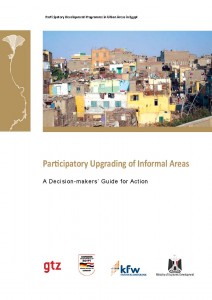This book on “Participatory Upgrading of Informal Areas: A Decision-makers’ Guide for Action” presents the model of participatory upgrading and how to apply it. It aims to simplify the complex issue of participatory upgrading drawing on Egypt’s experience.
The guidelines mainly target decisions-makers involved in upgrading informal areas, and more widely in local development. Among the key players are decision-makers on different levels of the government: local, regional and ministerial level. Accordingly, ministers, governors, district chiefs, heads of relevant departments such as urban planning, planning and monitoring, etc. will find these guidelines useful in explaining what the implementation of participatory upgrading mechanisms requires them to do. More importantly, the guidelines show decision-makers how their sphere interrelates and interacts with many others within and outside government administration and the type of cooperation to expect and endorse. Other groups of stakeholders such as civil society and the private sector will also benefit from these guidelines to understand how governmental bodies can implement and manage participatory upgrading on different levels and how they can complement the role of government. The guidelines are also targeting those working in local development, good governance or poverty alleviation.
Download: “Participatory Upgrading of Informal Areas. A Decision-makers’ Guide for Action” (English)
Download: “Participatory Upgrading of Informal Areas. A Decision-makers’ Guide for Action” (Arabic)
The volume consists of two parts. The first part “Basic Concepts” describes informal areas as a global phenomenon and their different types in Egypt. It also discusses what is meant by upgrading, why to upgrade and the reasons for using a participatory approach. It then presents the mechanisms and tools of participatory upgrading and their contribution to achieving agreed-upon objectives of local development. The second part ”Guidelines for Action” specifies the application of participatory upgrading on different levels and presents in detail each of its tools in terms of objectives, process steps, partners, framework conditions, capacity development requirements and expected outputs. The volume concludes by illustrating how these tools can interact in a complementary way; how they are implemented on the local level, managed on the regional level and supported by the national level.


